Example joint fit between GBM and Swift BAT¶
One of the key features of 3ML is the abil ity to fit multi-messenger data properly. A simple example of this is the joint fitting of two instruments whose data obey different likelihoods. Here, we have GBM data which obey a Poisson-Gaussian profile likelihoog ( PGSTAT in XSPEC lingo) and Swift BAT which data which are the result of a “fit” via a coded mask and hence obey a Gaussian ( \(\chi^2\) ) likelihood.
[2]:
%%capture
import matplotlib.pyplot as plt
np.random.seed(12345)
from threeML import *
from threeML.io.package_data import get_path_of_data_file
from threeML.io.logging import silence_console_log
Plugin setup¶
We have data from the same time interval from Swift BAT and a GBM NAI and BGO detector. We have preprocessed GBM data to so that it is OGIP compliant. (Remember that we can handle the raw data with the TimeSeriesBuilder). Thus, we will use the OGIPLike plugin to read in each dataset, make energy selections and examine the raw count spectra.
Swift BAT¶
[4]:
bat_pha = get_path_of_data_file("datasets/bat/gbm_bat_joint_BAT.pha")
bat_rsp = get_path_of_data_file("datasets/bat/gbm_bat_joint_BAT.rsp")
bat = OGIPLike("BAT", observation=bat_pha, response=bat_rsp)
bat.set_active_measurements("15-150")
bat.view_count_spectrum()
[4]:
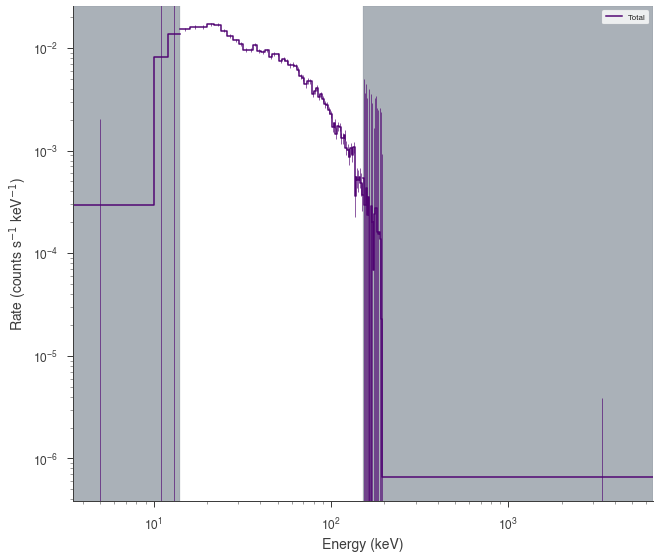
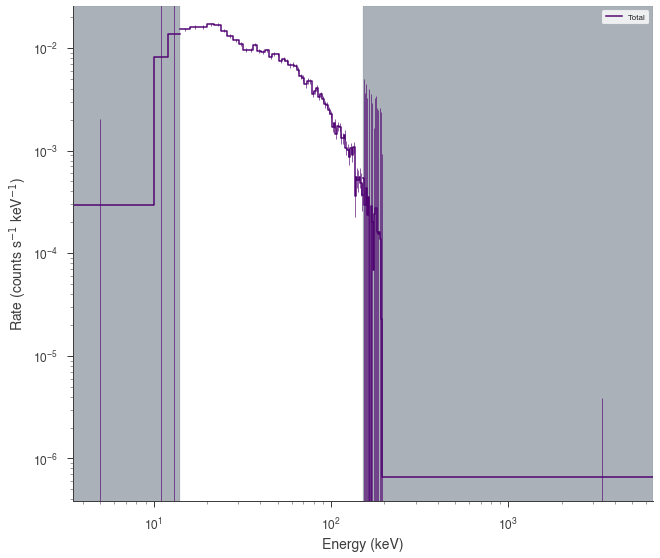
Fermi GBM¶
[5]:
nai6 = OGIPLike(
"n6",
get_path_of_data_file("datasets/gbm/gbm_bat_joint_NAI_06.pha"),
get_path_of_data_file("datasets/gbm/gbm_bat_joint_NAI_06.bak"),
get_path_of_data_file("datasets/gbm/gbm_bat_joint_NAI_06.rsp"),
spectrum_number=1,
)
nai6.set_active_measurements("8-900")
nai6.view_count_spectrum()
bgo0 = OGIPLike(
"b0",
get_path_of_data_file("datasets/gbm/gbm_bat_joint_BGO_00.pha"),
get_path_of_data_file("datasets/gbm/gbm_bat_joint_BGO_00.bak"),
get_path_of_data_file("datasets/gbm/gbm_bat_joint_BGO_00.rsp"),
spectrum_number=1,
)
bgo0.set_active_measurements("250-30000")
bgo0.view_count_spectrum()
[5]:
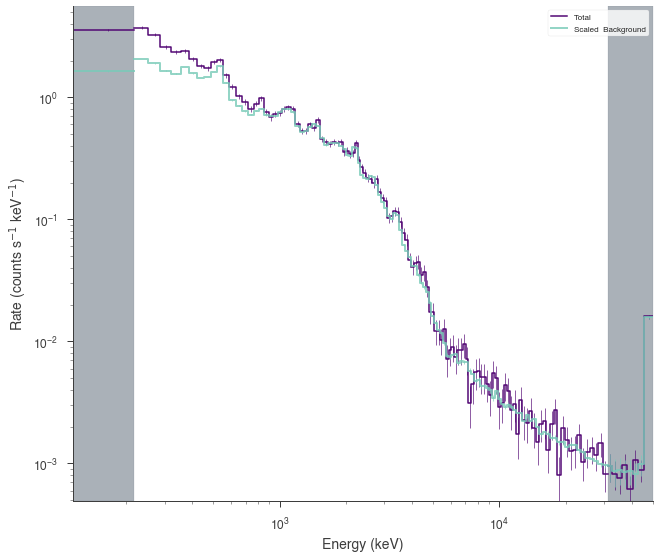
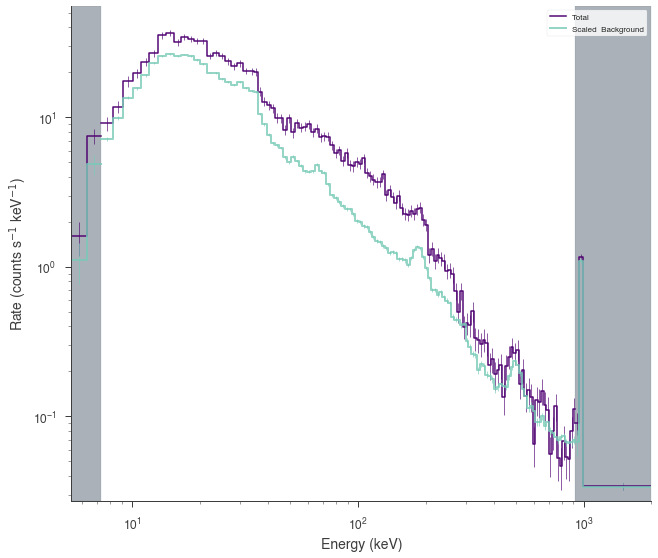
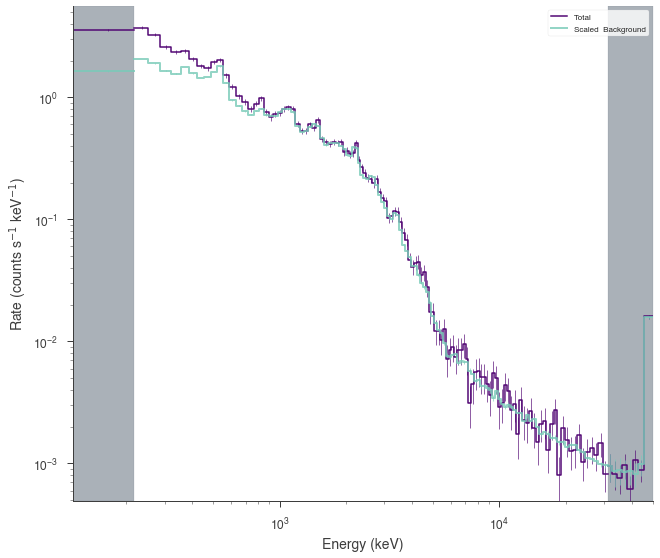
Model setup¶
We setup up or spectrum and likelihood model and combine the data. 3ML will automatically assign the proper likelihood to each data set. At first, we will assume a perfect calibration between the different detectors and not a apply a so-called effective area correction.
[6]:
band = Band()
model_no_eac = Model(PointSource("joint_fit_no_eac", 0, 0, spectral_shape=band))
Spectral fitting¶
Now we simply fit the data by building the data list, creating the joint likelihood and running the fit.
No effective area correction¶
[7]:
data_list = DataList(bat, nai6, bgo0)
jl_no_eac = JointLikelihood(model_no_eac, data_list)
jl_no_eac.fit()
Best fit values:
| result | unit | |
|---|---|---|
| parameter | ||
| joint_fit_no_eac.spectrum.main.Band.K | (2.75 +/- 0.06) x 10^-2 | 1 / (cm2 keV s) |
| joint_fit_no_eac.spectrum.main.Band.alpha | -1.029 +/- 0.017 | |
| joint_fit_no_eac.spectrum.main.Band.xp | (5.7 +/- 0.4) x 10^2 | keV |
| joint_fit_no_eac.spectrum.main.Band.beta | -2.41 +/- 0.18 |
Correlation matrix:
| 1.00 | 0.90 | -0.85 | 0.14 |
| 0.90 | 1.00 | -0.73 | 0.08 |
| -0.85 | -0.73 | 1.00 | -0.32 |
| 0.14 | 0.08 | -0.32 | 1.00 |
Values of -log(likelihood) at the minimum:
| -log(likelihood) | |
|---|---|
| BAT | 53.004207 |
| b0 | 553.011455 |
| n6 | 760.216969 |
| total | 1366.232632 |
Values of statistical measures:
| statistical measures | |
|---|---|
| AIC | 2740.599943 |
| BIC | 2755.306971 |
[7]:
( value negative_error \
joint_fit_no_eac.spectrum.main.Band.K 0.027476 -0.000557
joint_fit_no_eac.spectrum.main.Band.alpha -1.029036 -0.016662
joint_fit_no_eac.spectrum.main.Band.xp 566.986887 -37.816140
joint_fit_no_eac.spectrum.main.Band.beta -2.410083 -0.178486
positive_error error \
joint_fit_no_eac.spectrum.main.Band.K 0.000581 0.000569
joint_fit_no_eac.spectrum.main.Band.alpha 0.016928 0.016795
joint_fit_no_eac.spectrum.main.Band.xp 34.796218 36.306179
joint_fit_no_eac.spectrum.main.Band.beta 0.185936 0.182211
unit
joint_fit_no_eac.spectrum.main.Band.K 1 / (cm2 keV s)
joint_fit_no_eac.spectrum.main.Band.alpha
joint_fit_no_eac.spectrum.main.Band.xp keV
joint_fit_no_eac.spectrum.main.Band.beta ,
-log(likelihood)
BAT 53.004207
b0 553.011455
n6 760.216969
total 1366.232632)
The fit has resulted in a very typical Band function fit. Let’s look in count space at how good of a fit we have obtained.
[8]:
threeML_config.plugins.ogip.fit_plot.model_cmap = "Set1"
threeML_config.plugins.ogip.fit_plot.n_colors = 3
display_spectrum_model_counts(
jl_no_eac,
min_rate=[0.01, 10.0, 10.0],
data_colors=["grey", "k", "k"],
show_background=False,
source_only=True,
)
[8]:
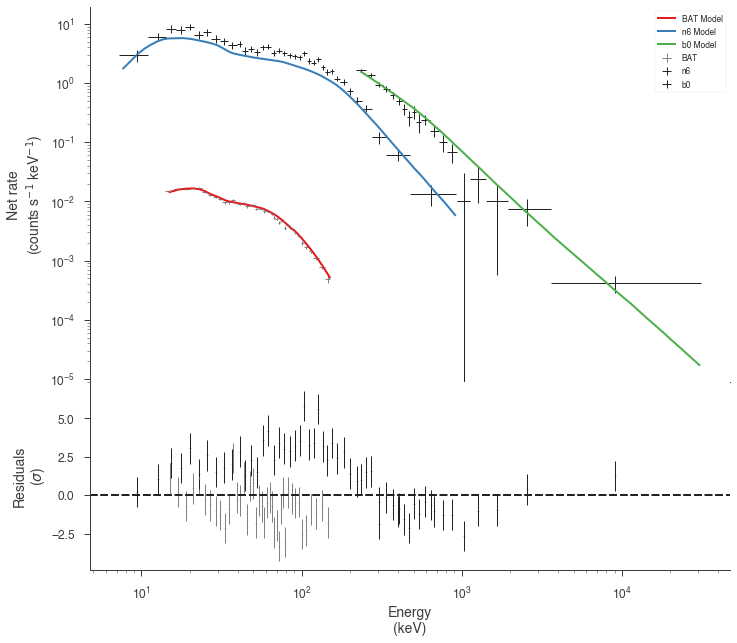
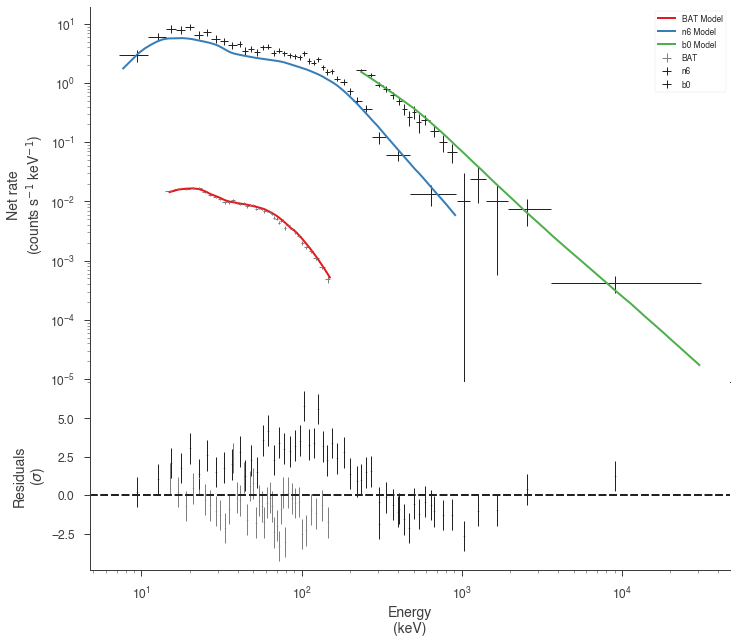
It seems that the effective areas between GBM and BAT do not agree! We can look at the goodness of fit for the various data sets.
[9]:
gof_object = GoodnessOfFit(jl_no_eac)
gof, res_frame, lh_frame = gof_object.by_mc(n_iterations=100)
[10]:
import pandas as pd
pd.Series(gof)
[10]:
total 0.0
BAT 0.0
n6 0.0
b0 0.5
dtype: float64
Both the GBM NaI detector and Swift BAT exhibit poor GOF.
With effective are correction¶
Now let’s add an effective area correction between the detectors to see if this fixes the problem. The effective area is a nuissance parameter that attempts to model systematic problems in a instruments calibration. It simply scales the counts of an instrument by a multiplicative factor. It cannot handle more complicated energy dependent
[11]:
# turn on the effective area correction and set it's bounds
nai6.use_effective_area_correction(0.2, 1.8)
bgo0.use_effective_area_correction(0.2, 1.8)
model_eac = Model(PointSource("joint_fit_eac", 0, 0, spectral_shape=band))
jl_eac = JointLikelihood(model_eac, data_list)
jl_eac.fit()
Best fit values:
| result | unit | |
|---|---|---|
| parameter | ||
| joint_fit_eac.spectrum.main.Band.K | (2.98 +/- 0.12) x 10^-2 | 1 / (cm2 keV s) |
| joint_fit_eac.spectrum.main.Band.alpha | (-9.84 +/- 0.26) x 10^-1 | |
| joint_fit_eac.spectrum.main.Band.xp | (3.31 +/- 0.32) x 10^2 | keV |
| joint_fit_eac.spectrum.main.Band.beta | -2.36 +/- 0.15 | |
| cons_n6 | 1.56 +/- 0.04 | |
| cons_b0 | 1.41 +/- 0.10 |
Correlation matrix:
| 1.00 | 0.95 | -0.92 | 0.31 | 0.29 | 0.62 |
| 0.95 | 1.00 | -0.82 | 0.26 | 0.26 | 0.52 |
| -0.92 | -0.82 | 1.00 | -0.36 | -0.45 | -0.77 |
| 0.31 | 0.26 | -0.36 | 1.00 | 0.04 | -0.03 |
| 0.29 | 0.26 | -0.45 | 0.04 | 1.00 | 0.47 |
| 0.62 | 0.52 | -0.77 | -0.03 | 0.47 | 1.00 |
Values of -log(likelihood) at the minimum:
| -log(likelihood) | |
|---|---|
| BAT | 40.079268 |
| b0 | 544.746813 |
| n6 | 644.532148 |
| total | 1229.358228 |
Values of statistical measures:
| statistical measures | |
|---|---|
| AIC | 2471.001202 |
| BIC | 2492.979019 |
[11]:
( value negative_error \
joint_fit_eac.spectrum.main.Band.K 0.029821 -0.001163
joint_fit_eac.spectrum.main.Band.alpha -0.983814 -0.026350
joint_fit_eac.spectrum.main.Band.xp 330.661044 -31.731660
joint_fit_eac.spectrum.main.Band.beta -2.360560 -0.153005
cons_n6 1.561041 -0.036678
cons_b0 1.410283 -0.094652
positive_error error \
joint_fit_eac.spectrum.main.Band.K 0.001169 0.001166
joint_fit_eac.spectrum.main.Band.alpha 0.025959 0.026154
joint_fit_eac.spectrum.main.Band.xp 30.915043 31.323351
joint_fit_eac.spectrum.main.Band.beta 0.154255 0.153630
cons_n6 0.038964 0.037821
cons_b0 0.098721 0.096687
unit
joint_fit_eac.spectrum.main.Band.K 1 / (cm2 keV s)
joint_fit_eac.spectrum.main.Band.alpha
joint_fit_eac.spectrum.main.Band.xp keV
joint_fit_eac.spectrum.main.Band.beta
cons_n6
cons_b0 ,
-log(likelihood)
BAT 40.079268
b0 544.746813
n6 644.532148
total 1229.358228)
Now we have a much better fit to all data sets
[12]:
display_spectrum_model_counts(
jl_eac, step=False, min_rate=[0.01, 10.0, 10.0], data_colors=["grey", "k", "k"]
)
[12]:
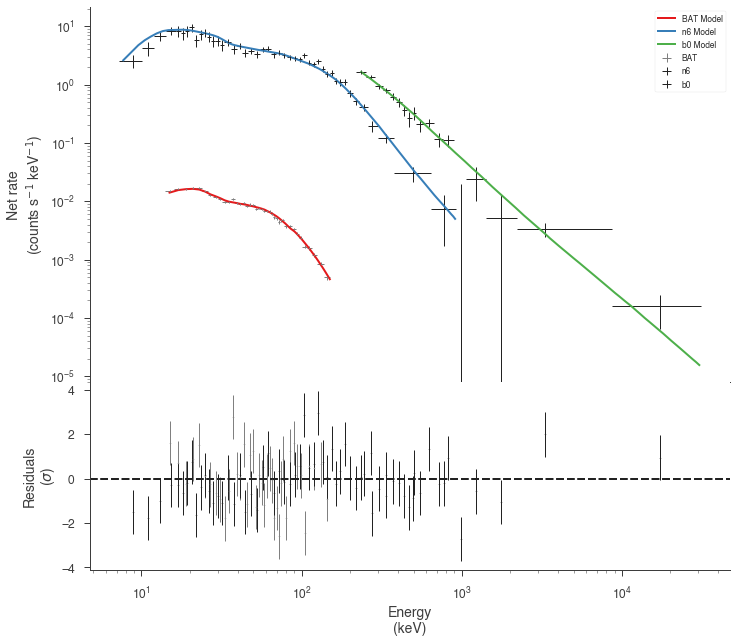
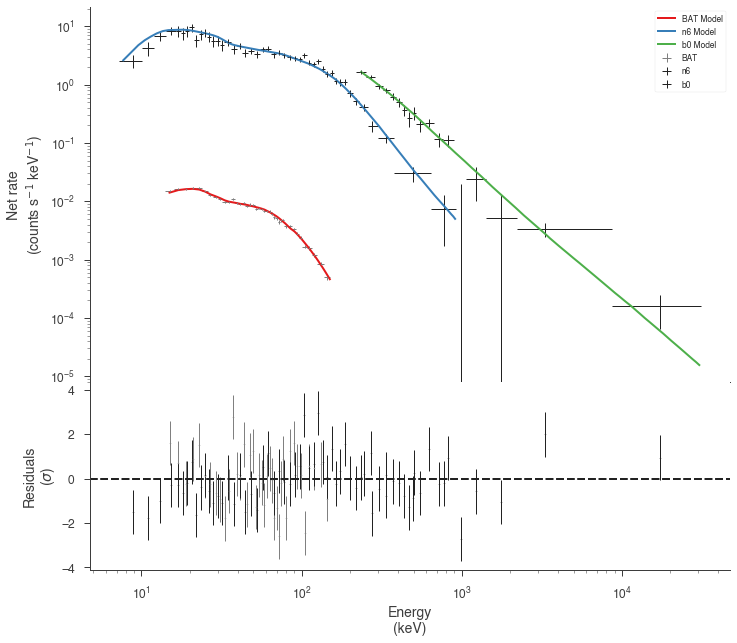
[13]:
gof_object = GoodnessOfFit(jl_eac)
# for display purposes we are keeping the output clear
# with silence_console_log(and_progress_bars=False):
gof, res_frame, lh_frame = gof_object.by_mc(n_iterations=100, continue_on_failure=True)
[14]:
import pandas as pd
pd.Series(gof)
[14]:
total 0.00
BAT 0.00
n6 0.00
b0 0.02
dtype: float64
Examining the differences¶
Let’s plot the fits in model space and see how different the resulting models are.
[15]:
plot_spectra(
jl_eac.results,
jl_no_eac.results,
fit_cmap="Set1",
contour_cmap="Set1",
flux_unit="erg2/(keV s cm2)",
equal_tailed=True,
)
[15]:
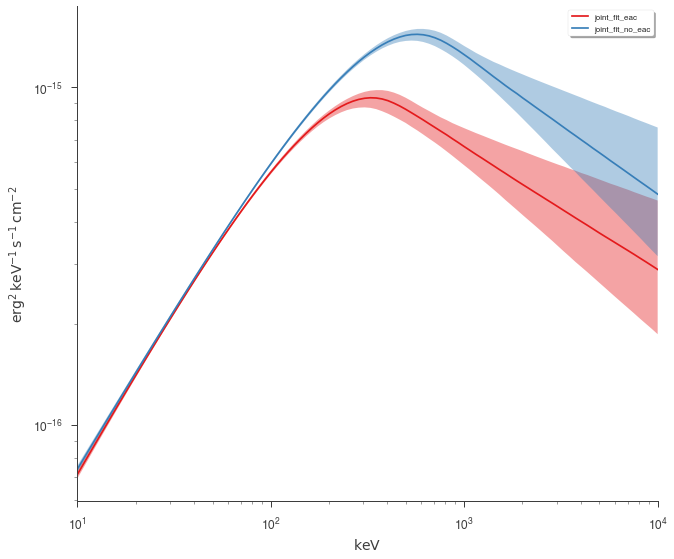
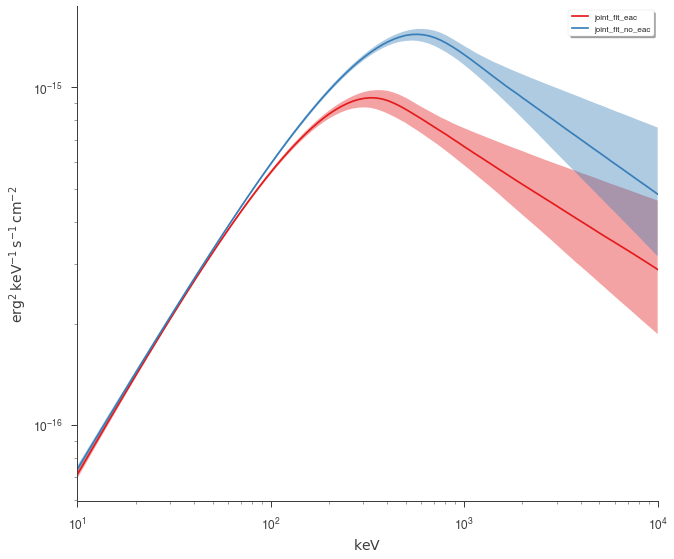
We can easily see that the models are different